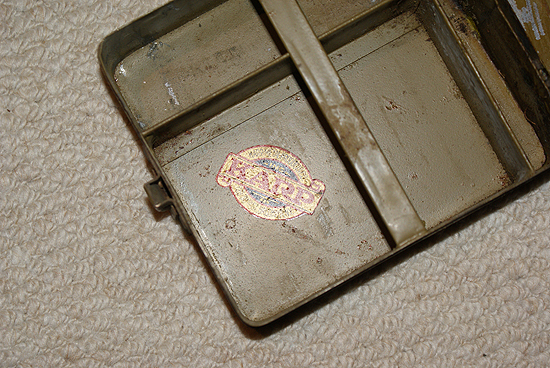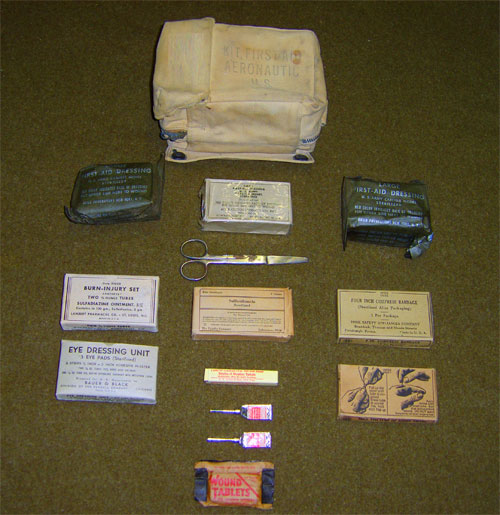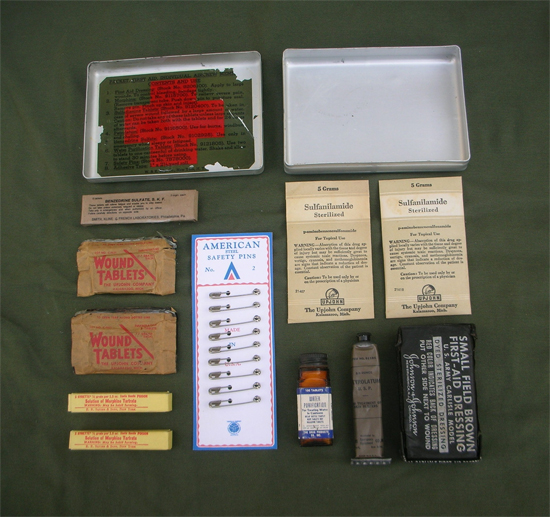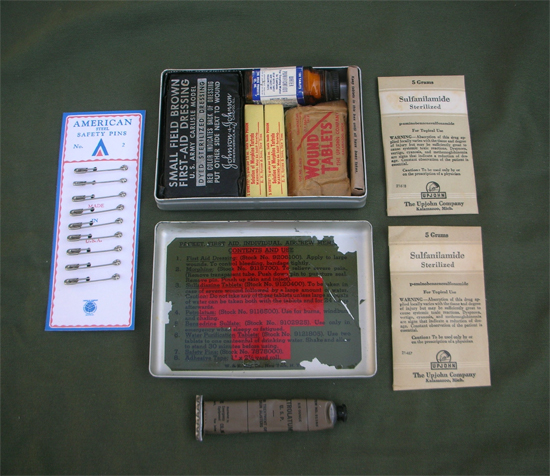Kits of Military Aircraft Medical Kits & Contents

Overall view of the Jungle First-Aid Kit. The markings shown in black (F-6-B) appear to be a representation of a particular unit or aircraft designation.
The Jungle First-Aid Kit (Large) was already developed in 1941 for supply to military aircraft flying over jungle areas. The Kit was specially designed for use in tropical areas, and contained a number of items specifically for use in the jungle and tropics. Typical products included Insect Repellent to keep mosquitoes and other insects away and avoid insect bites and stings; Atabrine Tablets to be taken as a precaution against Malaria; Water-Purifying Tablets to help improve the quality of impure drinking water; Salt Tablets to prevent the bad effects of heat and sweating; Snake-Bite Kit to prevent snake venom from spreading throughout the body; and Sulfaguanidine to treat Dysentery.

Illustration showing the contents sheet which is affixed to the lid of the Container.
Above designation (Large) was introduced to differentiate the wooden rectangular case (subdivided into 5 compartments or sections A, B, C, D, E) from the Jungle First-Aid Kit (Individual), supplied to each soldier fighting in jungle areas, which could be rolled into a bag and carried in a compartment of the jungle pack or haversack.
The Kit is already listed in the Medical Department Supply Catalog of 1942, under Appendix: Contents of Chests, Cases, etc. and Spare Parts. The Kit is also mentioned and briefly described in FM 21-11, War Department, Basic Field Manual, First Aid For Soldiers, dated April 7, 1943.
The Kit’s official designation is Kit, First Aid, Jungle, Item No. 9776300, with Container, Kit, First Aid, Jungle, Item No. 9766400 (1 March 1944 – ASF Medical Supply Catalog).
| 9776300 – Kit, First Aid, Jungle: | ||
|---|---|---|
 |
||
| Number | Item | Quantity |
| 9766400 | Container, Kit, First Aid, Jungle | 1 |
| 3705500 | Kit, Suction, Snakebite | 1 |
| 9112200 | Iodine Swab, 10 Min, 10 | 4 |
| 9115700 | Morphine Tartrate, 1 Tube | 24 |
| 9120110 | Repellent, Insect, 2 Oz | 12 |
| 9120200 | Sodium Chloride, 100 Tablets | 1 |
| 9120400 | Sulfadiazine, 8 Tablets | 12 |
| 9121810 | Tablet, Water Purification, Individual, 200 | 2 |
| 9200000 | Bandage, Gauze, Adhesive, White, 1 by 3 Inches, 16 | 5 |
| 9773400 | Container, Paper, 1 ½ by 4 Inches: 1 each for the following: | 3 |
| 1010000 | Acid, Acetylsalicylic, 1000 Tablets | 150 Tablets |
| 1057000 | Aloin Compound, 1000 Pills or Tablets | 200 Pills or Tablets |
| 1084500 | Atabrine Tablets, 100 Tablets | 100 Tablets |
| 9773400 | Container, Paper, 1 ½ by 4 Inches: 1 for each 200 of the following: | 2 |
| 1418000 | Sodium Bicarbonate and Peppermint, 1000 Tablets | 400 Tablets |
| 9773400 | Container, Paper, 1 ½ by 4 Inches: 1 for each 75 of the following: | 10 |
| 9120500 | Sulfaguanidine, 1000 Tablets | 750 Tablets |
Subsequent changes throughout the war years resulted in amended nomenclature and minor adaptations. In June 1943 the contents of the Insect Repellent bottles were reduced from 2 ½ oz to 2 oz., and one bottle of 100 Sodium Chloride Tablets (salt tablets) was added to the Kit. In March 1944, the 2 bottles of Halazone Tablets (Item No. 1K27507) were replaced by 2 bottles designated Water Purification Tablets, Item No. 9121810. The early number designating the bottles with Insect Repellent (1K31205) was amended and became Item No. 9120110. The (1942) code designating the container with the Sulfaguanidine Tablets was amended to read Item No. 1462600 (March 1944), while initial contents of 90 tablets decreased to 75. Later in WW2 (1945), the White fabric elements were replaced by Field Brown.
The above Jungle First Aid Kit was assembled and distributed by The George W. Luft Co., Inc., Long Island City, New York. Overall dimensions of subject case were 17 1/2 inch x 10 1/14 inch x 5 inch.
Above pictures courtesy of Kriss Usherwood.

Overall view of the Arctic First-Aid Kit.
The Arctic First-Aid Kit was developed in 1941 and supplied to aircraft going over Arctic areas. The Kit standardized in a wooden container (such as the Jungle First-Aid Kit), with small separate drug compartments, was designed for use in arctic and cold climates in order to provide a number of basic medical items for use by the crews of military aircraft flying over subject areas. The item was issued as directed by the AAF Base Supply Officers of Staging Areas or Aerial Ports of Embarkation, and distributed one per heavy or medium bomber, cargo, or transport airplane flying over Arctic areas.
The Kit contained in a wooden rectangular case was subdivided into 5 different compartments (designated sections A, B, C, D, E), each containing a specific number of items.
The Kit first appears in the 1942 Medical Department Supply Catalog, under Appendix: Contents of Chests, Cases, etc. and Spare Parts. It is also listed and briefly described and illustrated on pages 97 > 101, FM 21-11, War Department, Basic Field Manual, First Aid For Soldiers, dated April 7, 1943. In the 1943 Supply Catalog, it is listed under Section II: Medical Department Assemblages and Components Parts.
The Kit’s official designation is Kit, First Aid, Arctic, Item No. 9776200, with Container, Kit, First Aid, Arctic, Item No. 9766200 (1 March 1944 – ASF Medical Supply Catalog).
| 9776200 – Kit, First Aid, Arctic: | ||
|---|---|---|
 |
||
| Number | Item | Quantity |
| 9766200 | Container, Kit, First Aid, Arctic | 1 |
| 2013000 | Cotton, Absorbent, Compressed, 1 oz | 1 |
| 2034000 | Plaster, Adhesive, Surgical, 1-inch by 5 yards | 1 |
| 9101000 | Acid, Boric, Ointment, 1 oz | 1 |
| 9103800 | Burn Injury Set, Boric Acid Ointment | 3 |
| 9112200 | Iodine Swab, 10-minim, 10 | 2 |
| 9114500 | Mercuric Ointment, Ammoniated, 1 oz | 2 |
| 9115700 | Morphine Tartrate, 1 Tube | 24 |
| 9120200 | Sodium Chloride, 100 Tablets | 1 |
| 9120400 | Sulfadiazine, 8 Tablets | 12 |
| 9121810 | Tablet, Water Purification, Individual, 200 | 1 |
| 9200000 | Bandage, Gauze, Adhesive, White, 1-inch by 3 inches, 16 | 2 |
| 9200200 | Bandage, Gauze, Compress, White, 4-inch by 4-inch | 9 |
| 9773400 | Container, Paper, 1 ½ by 4 inches: 1 each for the following: | 5 |
| 1010000 | Acid, Acetylsalicylic, 1000 Tablets | 150 Tablets |
| 1057000 | Aloin Compound, 1000 Pills or Tablets | 200 Pills or Tablets |
| 1418000 | Sodium Bicarbonate and Peppermint, 1000 Tablets | 200 Tablets |
| 9103000 | Bismuth Subcarbonate, 500 Tablets | 200 Tablets |
| 9119000 | Protein Silver, Mild, 100 Tablets | 100 Tablets |
| 9773400 | Container, Paper, 1 ½ by 4 inches: 1 for each 200 of the following: | 2 |
| 1490500 | Vitamins, Multivitamin, 100 Capsules | 300 Capsules |
| 9773400 | Container, Paper, 1 ½ by 4 inches: 1 for each 75 of the following: | 2 |
| 1462600 | Sulfaguanidine, 1000 Tablets | 150 Tablets |
Between 1942 and 1944, subsequent changes resulted in amended nomenclature and minor adaptations. Phase-out of designations such as 1K27507 (Halazone Tablets), redesignated 912810; 1K24817 (Foille Tubes) redesignated and replaced by 9103800 Burn Injury Sets; 97733 (Paper Cardboard Containers) replaced by larger ones, Item No. 9773400; 91211 (Sulfanilamide Crystalline Envelopes) deleted; 92002 (Bandage Gauze Compress 4 by 4 in) reduced to 9 in lieu of 10 items.
In 1943 the number of Sulfaguanidine Tablets was 90, in 1944 it was increased to 150; the number of Foille Tubes initially only 3 was doubled.
Later in WW2 (1945), the standard White fabric elements were replaced by Field Brown.

Illustration showing the contents sheet which is glued to the lid of the wooden Container.
The above Arctic First-Aid Kit was assembled and distributed by the Davis Emergency Equipment Company, Inc., Newark, New Jersey. Based on the list of contents, it probably dates back to 1942-1943. The overall dimensions are identical to those of the Jungle First Aid Kit.
Above illustrations kindly supplied by Martyn Bateman.
| 97770 – Kit, First-Aid, Aeronautic, Complete: | ||
|---|---|---|
 Image courtesy of Kriss Usherwood. |
||
| Number | Item | Quantity |
| 2002 | Bandage, Gauze, Compress, White, 4-Inch by 4-Inch | 1 |
| 2004 | Bandage, Gauze, Compress, White, 2-Inch by 2-Inch, 4 | 2 |
| 2000 | Bandage, Gauze, Adhesive, White, 1-Inch by 3-Inch, 16 | 6 |
| 2010 | Bandage, Gauze, Compressed, White, 3-Inch by 6 Yards, 72 | 1 |
| 1122 | Iodine Swab, 10-minim, 10 | 1 |
| 1025 | Ammonia, Aromatic, 10 Ampules | 1 box of 3 |
| 1055 | Carron Oil, with 2% Phenol | 2 |
| 91035 | Tube, Boric Acid Ointment (with Ophthalmic Nozzle) | 1 |
The practice by the Medical Department of adding First-Aid Kits to aircraft was adopted from the German military, and standardized in 1932. Prior to the specification of the canvas container (Item No. 97766) in 1939, the Medical Department introduced a metal container labeled as Kit, First Aid, Aeronautic.
This metal container measures approximately 4½” x 5½” x 2” and was painted with a light brown drab color. The only markings to appear on the outside of the case were “KIT, FIRST AID AERONAUTIC” with a Greek-style red cross measuring 1½” square. Underneath this red cross was painted “MEDICAL DEPARTMENT, U. S. ARMY” It was opened and closed by means of a hinged lid, secure with a clasp fitted to one end. The inside was compartmentalized to hold the numerous contents of the kit, with a securing rib placed over the larger compartments to prevent the contents from falling out of the kit once opened.

Illustration showing the markings which appear on the metal container.
The exact method of securing the Kit to the aircraft is currently not known. However, it can be surmised that it was achieved by means of a bracket similar to those produced for other Vehicle First-Aid Kits of the Medical Department. According to AAF Manual 55-0-1, these kits were added to aircraft at the manufacturing facility. This kit was installed in all combat, cargo, transport, training planes, and gliders at the factory as well as in the E-8, E-11 and E-12 Emergency Sustenance Kits. Various maintenance units, replacement items, and kits for initial issue were requisitioned by the Medical Supply Officer of the base or command from the Medical Supply Branch, Headquarters Air Technical Service Command, on QMC Form 400. It was installed in an airplane on the basis of one kit for every two men or one per crew member at an isolated station, within easy access of the crew members.
Unlike the later models of Aeronautic First Aid Kit containers produced from various types of canvas, the metal variation did not feature any easy method of sealing the kit to prevent unauthorized or non-emergency access to its contents. This is an interesting point, since as required by Technical Orders, the Kit was to be always sealed when carried in aircraft, the seal bearing the proper Medical Department identification. This was to be broken only when injuries having resulted from aircraft accidents required the contents of the kit for treatment. The seal was not to be broken for routine inspection or for any purpose other than the treatment of injuries in flight.
As with other Vehicle First-Aid Kits of a similar construction, this metal container featured an instruction and contents sheet adhered to the underside of the hinged lid. Original contents of the kit were as follows:

Instruction and contents sheet adhered to the underside of the hinged lid on this early metal container. Image courtesy of Kriss Usherwood.
As can be seen, a number of these items were no longer present in subsequent versions of the Aeronautic First Aid Kit. The following item was omitted completely: Carron Oil with 2% Phenol (91055). In addition, the tube of Boric Acid Ointment (91035) was replaced by Item No. 91038 – Burn Injury Set; and the Gauze Compress Bandages were replaced by Large and Small First Aid Dressings. Later incarnations of the kit also featured the following items:
- 1 × Eye Dressing Set (Item # 9109500)
- 2 × Morphine Tartrate (Item # 9115700)
- 1 × Sulfadiazine, 8 Tablets (Item # 9120400)
- 1 × Sulfanilamide, Crystalline, 5, 5-Gm Envelopes (Item # 9121100)
- 1 × Scissors, 5 1/2-Inch, Straight, 1 Point Sharp (Item # 9369200)
- 1 × Tourniquet, Field (Item # 9378000)
It is likely that the sole contractor for this kit was Karp Metal Products Co. Inc. of Brooklyn, New York. Some examples of the container featured a gilded manufacturer’s mark adhered to the inside base of the container. The closing clasp facility was produced for Karp Metal Products by Corbin Metal.

Gilded manufacturer’s stamp inside the container. Also visible in this photograph are the numerous dividers contained within.
Since this particular item pre-dates the World War Two period, additional data are not available. The authors would welcome anyone who might have additional information about the kit’s installation procedure and mechanism to share this data, in the hope that this Article can be updated.
| 9776500 – Kit, First-Aid, Aeronautic, Complete: | ||
|---|---|---|
 |
||
| Number | Item | Quantity |
| 9776600 | Container, Kit, First-Aid, Aeronautic | 1 |
| 9103800 | Burn Injury Set, Boric Acid Ointment | 1 |
| 9109500 | Eye Dressing Set | 1 |
| 9115700 | Morphine Tartrate, 1 Tube | 2 |
| 9120400 | Sulfadiazine, 8 Tablets | 1 |
| 9121100 | Sulfanilamide, Crystalline, 5, 5-Gm Envelopes | 1 |
| 9200300 | Bandage, Gauze, Compress, Field Brown, 4-Inch by 4-Inch | 1 |
| 9205100 | Dressing, First-Aid, Large, Field Brown | 2 |
| 9206100 | Dressing, First-Aid, Small, Field Brown | 1 |
| 9369200 | Scissors, 5 1/2-Inch, Straight, 1 Point Sharp | 1 |
| 9378000 | Tourniquet, Field | 1 |
| OUTSIDE ENVELOPE OF KIT TO CONTAIN: | ||
| 9112200 | Iodine Swab, 10-minim, 10 | 1 |
| 9200100 | Bandage, Gauze, Adhesive, Field Brown, 1-Inch by 3-Inch, 16 | 1 |
The Aeronautic First-Aid Kit was, according to FM 21-11, issued to almost every aircraft, one to each aircraft station, while TM 71-220 states, that a minimum of five Kits was required per aircraft. However photographic evidence exists showing that these kits were certainly carried in greater numbers in troop carrying aircraft. Indeed as per AAF Manual 55-0-1, the Kit was installed in an airplane on the basis of 1 Kit for every two men, or 1 per crew member at an isolated Station, within easy access of crew members (and passengers). Bombers would normally have 4 Kits per plane, while Fighters would have 1 Kit per plane. Availability of such Kits on numerous occasions saved lives by enabling prompt emergency treatment of injuries.
The Aeronautic First-Aid Kit was installed in ALL combat, cargo, transport, training planes, and gliders at the Factory! As required by T.O. (Technical Orders), the Kit was to be placed on board the aircraft (it was recommended to check its presence before any mission); it was always to be sealed (wire sufficiently small to be broken in case of emergency); it was to be stowed in its designated location (easily accessible); and if missing, it was to be replaced prior to flight. Morphine Syrettes, Sulfanilamide, and Halazone Tablets were to be removed from training aircraft, but NOT from combat planes.

Paratroopers of the 101st Airborne Division prepare to jump into Normandy on the night of 5/6 June 1944. An Aeronautic First-Aid Kit can be clearly seen mounted to the fuselage of the C-47 transport aircraft.
The canvas rectangular case closed with a zipper (when completely opened, it allowed to unfold the container) and seal bearing the proper MD identification and consisted of two separate large compartments, with a smaller separate pouch closing with a press stud, while the outside envelope also contained some limited medical items. The rear was foreseen with a large canvas loop (in fact a sort of handle), and stitched onto a rectangular flap with four Lift-the-Dot fasteners, two at the top, and two at the bottom, which clicked into four male fasteners located at some specific spots for securing the Kit to the aircraft’s bulkhead. There was an early version, in khaki-colored canvas, followed by an olive-drab version, and a late war/postwar waterproofed version, with only minor modifications.
The table with contents illustrates the mid-1944 listing, part of the 1 March 1944 Army Service Forces Catalog MED and already underwent minor modifications when compared to earlier versions. The difference in contents between 1943 and later periods is minimal, although it is not always understandable why some items were later replaced or even deleted. As in other First-Aid Kits, White Bandage material was replaced by Field Brown or Dyed versions.
The USAAF P.I.F. (Pilot’s Information File) Section 8 (i.e. 8-13-2) dated 1 October 1943 (Revised) indicated following std. contents:
1 Container, Kit, First-Aid, Aeronautic; MAIN KIT: 1 Tube, Burn Injury Set, Boric Ointment; 1 Eye Dressing Set; 2 Morphine Tartrate, Tubes; 1 Box, Sulfadiazine, 12 Tablets; 1 Envelope, Sulfanilamide, Crystalline; 3 Dressings, First-Aid, Small, White; 1 Scissors, 4-Inch, Straight, 1 Point Sharp; 1 Tourniquet, Field, with Pad; OUTSIDE ENVELOPE OF KIT: 1 Box, Iodine Swab, 10-Minim, 10; 1 Box, Bandage, Gauze, Adhesive, 1-Inch x 3-Inch, 16; 1 Bottle, Halazone Tablets, 100.
Notes:
It should be noted that P.I.F. documents not only recommended that the Packet, First-Aid, Parachute (Item No. 9778500) was to be attached to the parachute harness for constant availability, but also that it should be carried in gun turrets and other cramped spaces of aircraft where the larger (Aeronautic) kits were not accessible!
In 1945, The Air Surgeon ordered that Kits, First-Aid, Aeronautic (Item No. 9776500) be replaced in Fighter Aircraft (lack of real space) by the new Packet, First Aid, Individual, Air Crew Member, Stock No. 8300-623715 (Medical Item No. 9714000), developed by the Aero Medical Laboratory for the use of fighter pilots. An initial procurement of 15,000 Kits in aluminum cases were made by Class 13, Supply Division, ATSC, for distribution to Fighter organizations overseas.
| 9714000 – Packet, First Aid, Individual, Aircrew Member: | ||
|---|---|---|
 |
||
| Number | Item | Quantity |
| 9714005 | Case, First Aid Kit, Air Crew, Individual, Empty | 1 |
| 9206100 | Dressing, First-Aid, Small, Field Brown (Camouflaged) | 1 |
| 9121100 | Sulfanilamide, Crystalline, 5-Gm Envelope | 2 |
| 9115700 | Morphine Tartrate Syrette, ½ gr. | 2 |
| 9120400 | Sulfadiazine, 8 Tablets, 7 ½ gr. | 2 |
| 9116500 | Petrolatum, Tube, ½ oz. | 1 |
| 9102925 | Benzedrine Sulfate, 6 Tablets | 1 |
| 9121805 | Tablet, Water Purification, 100 | 1 |
| 7878000 | Pins, Safety, Medium, 9s | 1 |
| – | Plaster, Adhesive, Field Brown, 1″ x 2 ½ yard roll | 1 |
The Packet, First Aid, Individual, Aircrew Member (Air Corps Stock No. 8300-6237125) was introduced late in WW2 and only gradually issued to each individual aircrew member for his original needs. It was intended primarily for the use of Fighter pilots since the Kit, First Aid, Aeronautic (Medical Item No. 9776500) was removed from fighter aircraft, as the latter was considered too bulky for the already cramped cockpit. Moreover its compact size allowed it to be easily stashed away in the pilot’s clothing or stored with his personal effects. After use of the contained items, replacements were to be obtained from the Medical Supply Officer. Items showing signs of deterioration were to be immediately replaced. Particular attention was to be given to the condition of the morphine syrettes which could be crushed or have the seal damaged on high altitude flights.

Contents of Packet, First Aid, Individual, Air Crew Member. Only 8 out of 9 items are illustrated, since it proved impossible to find the Tape, Adhesive, Roll and its rectangular box, as used in World War 2.
The Packet consisted of a rectangular aluminum container (Medical Item No. 9714005), divided into 2 parts, cover and case, which after having been filled, and snapped together, were then sealed with black adhesive tape, bearing the following inscription: SAVE THIS TAPE – USE TO RESEAL PACKET OR DRESS WOUNDS. A decal (olive drab background, red cross, list of contents & use) was fixed inside the cover. While this particular item appeared in the Personal Equipment Officers, AAF Manual 55-0-1, dated May 1945, under Chapter Eleven, First Aid Equipment, it was never included in the Army Service Forces Medical Supply Catalog, 1 March 1944. It is however listed in both the Army-Navy Catalog of Medical Material of 1 July 1947 (Item 9-196-800), and the Armed Services Catalog of Medical Matériel, 1 July 1949 (Item No. 9-196-800, with slightly different contents). While on the subject, it must be noted that the 1947 Catalog still listed the Kit, First Aid, Aeronautic, Item No. 9-196-650.
The above Packet, First Aid, Individual, Aircrew Member, was manufactured and supplied by W. & K. Mfg. Co., New York, N.Y.

It should be noted that some time during late 1944 – mid 1945, Packet contents did change, since the Sulfanilamide Crystalline Envelopes were deleted. Consequently only 8 items were now left in the aluminum container (please see cover decal).
Notes:
The June 1945-11-C-2 List of First Aid Equipment Kits, included following items:
1 Case; 2 Morphine Tartrate (tubes with individual box); 9 Pins, Safety, Medium (carton); 2 Sulfadiazine, Tablets (individual kraft paper wrapper); 100 Tablets; Water Purification (1 bottle); 6 Tablets, Benzedrine, Sulfate (box); 1 Tape, Adhesive (roll with box); 1 Dressing, First-Aid, Small, Field Brown (with wrapper); 2 Sulfanilamide, Crystalline, 5-Gm (individual paper envelope); 1 Petrolatum, Ointment (tube no wrapper).
Subsequent changes only appeared in the July 1947 and the July 1949 Catalogs, with following items either deleted or replaced, such as:
Items deleted – Morphine Tartrate Syrettes; Water Purification Tablets; Benzedrine Sulfate Tablets; Adhesive Plaster Roll; Sulfanilamide Crystalline Powder.
Items replaced (new or addition) – Amphetamine Sulfate Tablets; 12 Pins, Safety, Medium; Adhesive Plaster (now a spool 1” x 2 ½ yds); Petrolatum, Tube (1 or 2 tubes).
